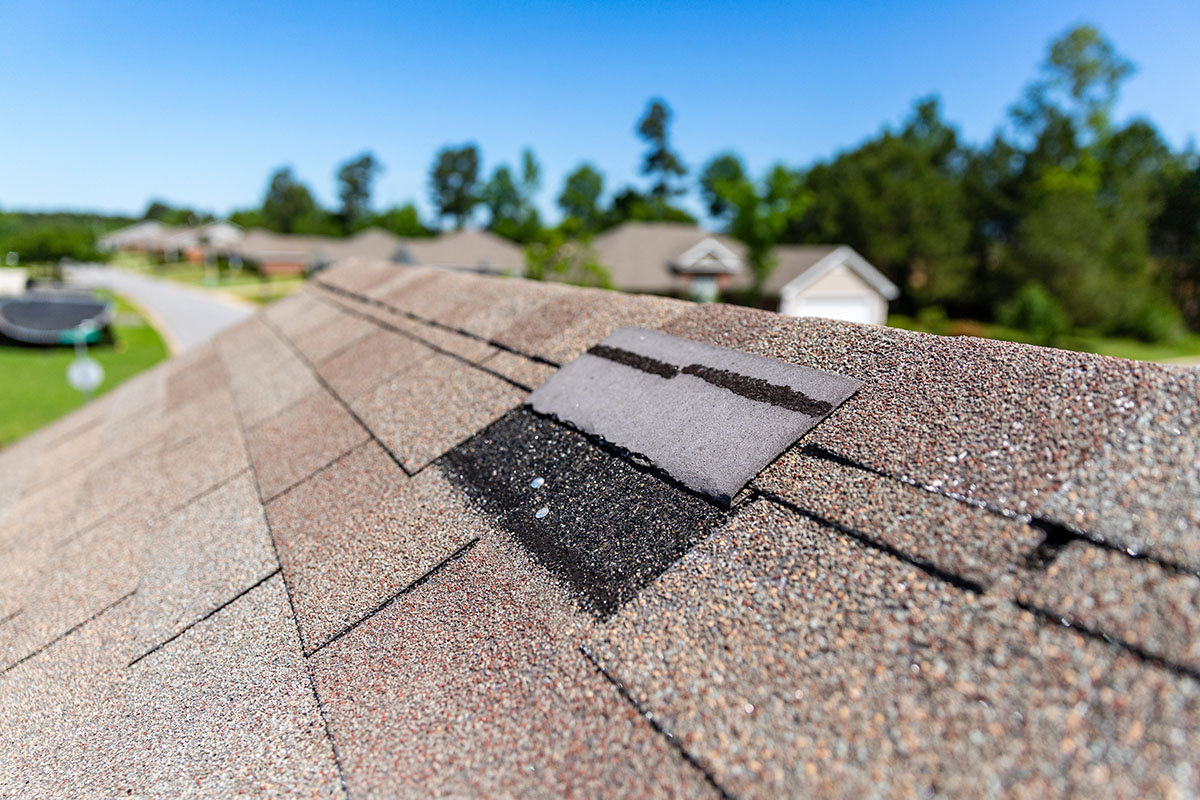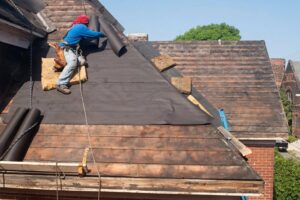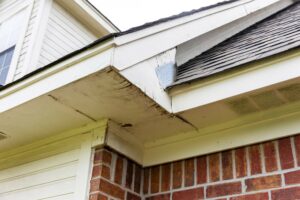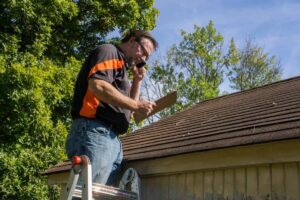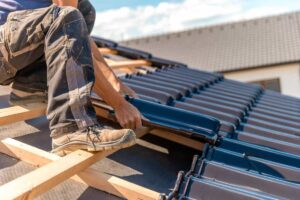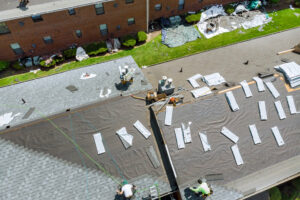Maintaining a healthy roof is essential for safeguarding your home. A well-kept roof protects against elements like rain, wind, and heat while enhancing your property’s curb appeal. Neglecting roof maintenance can lead to significant issues, including structural damage and costly repairs.
Key signs indicating the need for roof repairs or replacement include:
- Minor leaks and water stains on ceilings or walls
- Missing or cracked shingles
- Damaged flashing around chimneys and vents
Recognizing these telltale signs early can save you from extensive damage and expensive repairs down the line. Understanding how to tell if your roof needs repairs or replacement is crucial in ensuring the longevity of your home. Regular assessments of your roof condition will help you make informed decisions regarding necessary interventions.
Understanding Roof Condition
Regular assessment of your roof’s condition is crucial for maintaining its integrity and preventing costly damage. You should conduct inspections at least once a year, especially after severe weather events. This proactive approach helps identify minor issues before they escalate into major problems.
Impact of Age on Repair vs. Replacement Decisions
The age of your roof plays a significant role in determining whether repairs or a full replacement is necessary.
- Roofs older than 20 years often require more frequent repairs, suggesting replacement may be more cost-effective.
- A roof in good condition but nearing the end of its lifespan could benefit from repairs if the damage is limited.
- If extensive deterioration occurs or multiple repairs are needed, opting for a replacement will ensure long-term structural integrity.
Signs Your Roof Needs Repairs
Recognizing the signs that indicate your roof requires repairs is crucial for maintaining a safe and functional home. Look for the following common indicators:
1. Minor Leaks and Water Stains
Water stains on ceilings or walls can signify leaks in your roof. These brown or yellowish spots may seem minor, but they can point to more significant underlying problems.
2. Visible Damage
Inspect your roof for missing or cracked shingles. This visible roof damage compromises your roof’s integrity and increases the likelihood of leaks.
3. Damaged Flashing
Check the flashing around chimneys and vents. Damaged or improperly installed flashing can allow water to seep into your home, leading to further complications.
Addressing these issues promptly is essential. Ignoring minor damage can lead to extensive problems, including mold growth and structural damage. Acting at the first sign of trouble helps protect not just your roof but also the entire structure of your home.
Signs of Water Damage
Water stains are usually the first visible sign of roofing problems. These brown or yellow spots on ceilings and walls can provide important clues about potential leaks. By figuring out where these stains are located, you can find out where the moisture is coming from:
- Near chimneys or vents: This could mean there’s damage to the flashing.
- Widespread staining: This suggests there are extensive issues with the roof.
The Dangers of Trapped Moisture
Moisture that gets trapped in your home can cause serious problems, especially when it comes to mold growth. In damp conditions, mold can start to grow within just 24 hours. This can lead to health issues and expensive cleanup costs.
When to Call a Professional
If you notice any active leaks, it’s important to get a professional opinion right away. Water droplets during rainstorms are a clear sign that you need a thorough inspection to prevent more damage. Acting quickly is crucial in reducing the risks that come with water intrusion and protecting your home’s structure.
Signs Your Roof Needs Replacement
Identifying major warning signs that indicate a roof needs replacement can save you from significant damage and expense. Key indicators to watch for include:
- Sagging or Uneven Roofline: A sagging roof structure often signals underlying issues with the roof’s support system. This condition may compromise the entire structure, requiring immediate attention.
- Persistent Ceiling Leaks: If leaks continue after repairs, this is a clear sign of deeper problems. It suggests that water has penetrated the roofing system, potentially leading to extensive damage within your home.
- Curling or Buckling Shingles: Shingles that curl or buckle are not just unsightly; they indicate structural problems. These issues can stem from inadequate ventilation or age-related deterioration, compromising the roof’s integrity and performance.
Aging roofs often exhibit these signs as their materials lose effectiveness over time. Addressing these indicators promptly is essential to prevent further complications and protect your home’s value.
Evaluating Roof Age and Material Condition
Understanding the lifespan of various roofing materials helps in making informed decisions regarding repairs or replacements. Here’s a brief comparison:
Roofing Materials and Their Lifespans:
- Slate: 75–200 years
- Clay/Concrete Tiles: 50–100+ years
- Metal Roofing: 40–80 years
- Wood Shingles: 30–50 years
- Architectural Asphalt Shingles: 30 years
- Three-tab Asphalt Shingles: 20 years
- EPDM Rubber: 15–25 years
Evaluate whether repairs are sufficient based on the roof’s age and condition. A roof over 20 years old, especially asphalt shingles, may require replacement rather than continued repairs.
Cost implications play a crucial role in this decision-making process. Continued repairs can accumulate costs, often approaching 30% of full replacement expenses. If multiple issues arise or frequent repairs are needed, investing in a new roof becomes more cost-effective in the long run. Structural evaluations are essential to determine the best course of action tailored to your specific situation.
The Importance of Regular Roof Inspections
Regular inspections are crucial for maintaining the integrity of your roof. They allow you to identify minor issues before they escalate into significant problems.
Benefits of Regular Inspections:
- Early Detection: Catching small leaks or damaged shingles early can save you from costly repairs later.
- Warranty Compliance: Many roofing warranties require regular inspections to maintain coverage.
- Informed Decisions: Understanding your roof’s condition helps you determine whether repairs or replacement is necessary.
Recommended Inspection Practices:
- Shingle Condition: Look for missing, cracked, or curled shingles that may compromise your roof’s effectiveness.
- Flashing Examination: Check the areas around chimneys, vents, and skylights for signs of damage or wear.
Implementing these practices ensures you stay ahead of potential issues, preserving the longevity of your roof. Regular assessments enhance energy efficiency and protect your home’s interior from water damage.
DIY Roofing Tips and When to Call a Contractor
Taking a proactive approach to roof maintenance can save you time and money. Here are some DIY roofing tips to consider:
- Inspect Regularly: Look for missing or damaged shingles. Address any visible issues immediately.
- Clear Debris: Remove leaves, twigs, and dirt from gutters and roof surfaces to prevent water buildup.
- Check Flashing: Ensure flashing around chimneys and vents is intact to avoid water leaks.
- Seal Minor Cracks: Use roofing sealant for small cracks or holes.
Certain situations require professional intervention. A professional assessment is essential when you notice:
- Persistent leaks despite DIY efforts.
- Significant sagging or structural concerns.
- Widespread damage that is beyond simple repairs.
Cost Considerations: Repairs vs. Replacement
Understanding the cost of roof repairs vs replacement is essential when deciding on your roofing needs. Here are some key points to consider:
1. Repair Costs
- Minor repairs typically range from $300 to $1,000.
- Economical for localized damage if the roof is less than 10-15 years old and less than 30% damaged.
2. Replacement Costs
- New roofs range from $5,000 to $15,000, significantly impacting your budget.
- A new roof may increase your home’s resale value by approximately $12,000 to $15,000.
3. Financing Options
- Many contractors offer financing plans to help manage the costs.
- Some roofing materials come with transferable warranties, adding future value.
Assessing these factors ensures you make an informed decision about whether to repair or replace your roof. Understanding these cost implications can guide you in deciding what’s best for your home.
Making Smart Roofing Decisions: Your Home’s Shield and Security
Maintaining a healthy roof is crucial for the longevity and safety of your home. Recognizing the signs that indicate whether you need repairs or a full replacement can save you time and money.
Key takeaways include:
- Regular Inspections: Schedule routine assessments to catch minor issues before they escalate.
- Signs of Damage: Look for leaks, missing shingles, or sagging areas that signal immediate attention.
- Roof Age Matters: Be aware of your roof’s material and lifespan. Aging roofs often require more frequent repairs.
When deciding between repair and replacement, consider:
- Extent of damage
- Roof age
- Long-term cost implications
Consulting professionals ensures you receive expert evaluations tailored to your specific situation. This approach leads to informed decisions about maintenance and upgrades, enhancing your home’s value and energy efficiency.
Investing in a new roof not only improves your property’s overall performance but also contributes to environmental sustainability. With proper care and timely action, you can extend the life of your roof and protect your home for years to come.
FAQs
What are the key signs that indicate my roof needs repairs?
Common signs of roof damage include visible leaks and water stains on ceilings or walls, missing or cracked shingles, and damaged flashing around chimneys and vents. Addressing these minor issues promptly can prevent extensive damage.
How often should I have my roof inspected for potential issues?
Regular inspections are crucial for maintaining a healthy roof. It’s recommended to conduct inspections at least once a year, or after severe weather events, to identify minor issues before they escalate into major problems.
What roofing materials have the longest lifespan?
Different roofing materials vary in lifespan; for instance, slate roofs can last up to 100 years, metal roofs typically last 40-70 years, while asphalt shingles generally last around 20-30 years. Understanding the lifespan of your roofing material helps in evaluating repair vs. replacement decisions.
When is it necessary to replace my roof instead of repairing it?
Major warning signs for roof replacement include a sagging or uneven roofline, persistent leaks after repairs have been made, and curling or buckling shingles indicating structural problems. If your roof is aging and showing these signs, replacement may be the best option.
What are the cost implications of continued repairs versus full roof replacement?
Continuing to repair an aging roof can become increasingly costly over time. Evaluating the age and condition of your roofing materials is essential; in many cases, investing in a full replacement may be more cost-effective than ongoing repairs.
What DIY tips can I follow for minor roofing maintenance?
For minor maintenance tasks, check the condition of shingles regularly, inspect flashing around vents and chimneys for damage, and clear debris from gutters. However, if you encounter significant issues or active leaks, it’s best to call a professional contractor for a thorough assessment.

